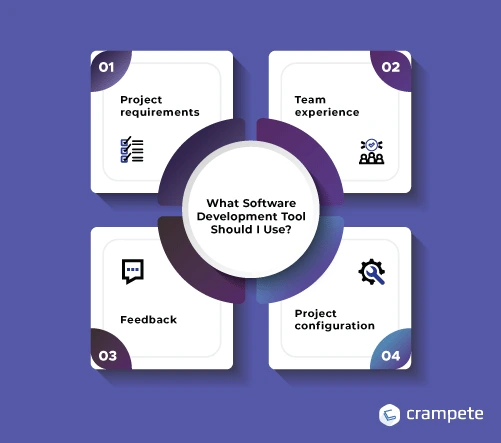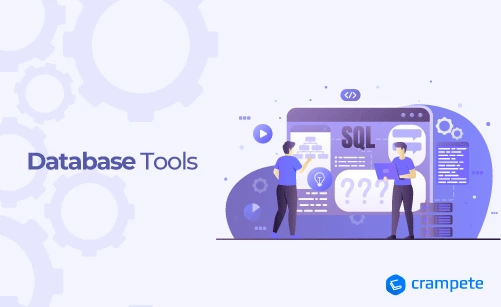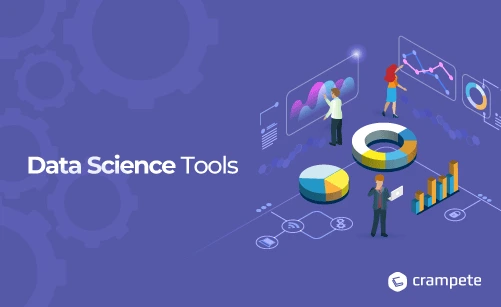
Best Software Development Tools
Software engineers top the list of those who are overly privileged for choice. A rookie developer may become confused about the finest software development tools and frameworks since there are so many options available, which may often overwhelm them. It's crucial to grasp fundamental tools and frameworks that may assist you in writing production-ready code, especially for new hires who are strong in theoretical parts of programming.
We have put up a list of the top software development tools and frameworks to assist you in making the best choice. These tools may provide you an excellent foundation for your software development career and help you keep one step ahead of the competition.
TABLE OF CONTENT
- What is a Software Development Tool?
- What Software Development Tool Should I Use?
- Best Software Development Tools
- Developer Tools
- IDE Tools
- Database Tools
- Frameworks
- Cloud Tools
- Data Science Tools
- Source Control Tools
- Prototyping Tools
- DevOps Tools
- Notification Tools
- Conclusion
What is a Software Development Tool?
Software professionals use program development software called a "software development tool" or "software programming tool" to build, manage, modify, support, and debug other programs, frameworks, or applications.
Today, there are hundreds of thousands for programming tools or developing software. Making the best choice might be difficult. The project kind, however, has a complete impact on the decision about the software development tool. When selecting the finest software development tool, there are a few things to keep in mind.

What Software Development Tool Should I Use?
It may make or break a project to choose a developer software product that is technically sound. Every project has certain requirements that must be satisfied via brainstorming to find the best match. To do this, take into account the following:
1. Project requirements
To succeed, you must be well familiar with your project. Every project has unique requirements, making the perfect software development tool impossible to find. This will provide you the ability to select the ideal fit using the technologies at your disposal. At the end, you'll see a system that is ready to deliver the best outcomes given the available time and resources. An important question to address is how it will function in the project's execution as a whole.
2. Team experience
It is important to take into account the team's expertise, familiarity, and comfort level with the selected web developer software solutions. It will be possible to gauge everyone's ideas through discussions among the developers based on their accumulated knowledge. Before you make a decision, be sure that every member of your team has been heard.
3. Feedback
Feedback can show whether or not the project's expectations match reality. Even if you might not give it much thought right now, you can use this as a guide in the future. It is crucial to avoiding making the same errors again in subsequent trials.
4. Project configuration
Pay careful consideration to the project's preliminary scope. You may use it to help you focus your search for software developer productivity tools. Some software is created specifically for smaller projects. As everything is set up, think through how your project will work with the available testing cycles to prevent running into this problem.
Best Software Development Tools
Today, a wide range of software development tools are accessible. These tools fall under distinct categories. The highlighted one’s are given below, categorized by kind.
Developer Tools
1. Embold
A software development tool called Embold examines source code and identifies different flaws that have a big impact on a project's security, robustness, stability, and maintainability.
It is a platform for software analytics with a wide range of integrated plugins. A feature that detects anti-patterns aids users in avoiding the synthesis of unmaintainable code.
A number of additional technologies, like GitHub, Azure, BitBucket, etc., are effortlessly integrated with Embold. Additionally, it integrates with Git and the plugins used by Eclipse and IntelliJ IDEA. It offers faster and more thorough language assessments for over 10 different languages.
Features:
- A tool for software testing that analyzes code and finds bugs
- different plugins to improve functionality
- A variety of software versioning tools integration
2. Linx
Linx is another low-code software development tool. Back-end applications and web services are developed and automated using it. Additionally, it supports APIs, integrations, and automation without the need for coding, frameworks, or infrastructure.
Linx provides a user-friendly drag-and-drop interface. It facilitates simple database and system integration while accelerating the creation and automation of business operations. For quick development, there are more than 100 built-in programming features and services.
With just one click, you can install your apps or services on any local or cloud server. It supports any SQL or NoSQL databases, numerous file types, including text and binary, and REST and SOAP web services. Linx also enables you to automate procedures using a message queue, a timer, or directory events.
Features :
- web development automation with low-code software, especially for the back end.
- UI that uses drag and drop to automate and integrate databases, external systems, and functions
- Simple deployment using a local or cloud server.
IDE Tools
Use the below tools to edit, debug, and run the source code.
3. Netbeans
An Integrated Development Environment (IDE) for creating Java applications is called Netbeans (also PHP, among others). It offers several tools, such as code completion, refactoring, and a debugger, that make Java programming simpler. Additionally, it works nicely with other tools like Maven and Ant.
Best-in-class desktop, online, and mobile apps may be created with this platform fast and easily. Numerous programming languages, including Java, JavaScript, PHP, C, and C++, are supported by NetBeans.
A cross-platform development tool called NetBeans works with a variety of operating systems, including Linux, Solaris, Windows, and macOS. NetBeans has grown in popularity among developers thanks to its smart code editing, simple management procedure, creating bug-free and error-free code, and speedy user interface development capabilities.
It is also one of the greatest development tools because of features like profiling, debugging, a strong GUI interface, support for Java platforms, and committed community support. The code converters, editors, and analyzers provided by NetBeans make it simple for users to upgrade their Java programs to more recent versions.
Features
- Cross-platform programming is able to work with and execute both online and mobile applications.
- Java support with good GUI and debugging tools.
- Existing Java apps and packages are simple to upgrade.
4. Cloud 9 IDE
A cloud-based integrated development environment (IDE) called Cloud 9 IDE enables programmers to write, execute, and debug code from any location in the globe. It supports a variety of programming languages, including reactjs, php, Ruby on Rails, python, JavaScript, and more.
The following are only a few of the capabilities and advantages that Cloud 9 IDE provides:
It is a powerful software development tool with capabilities like file dragging, code completion recommendations, and debugging, among others. The whole development environment is replicated. Amazon Web Services (AWS) acquired this tool in 2016 and made significant improvements. Cloud 9 is now billed according to consumption thanks to aws.
Features
- Real-time collaboration is made simple by the Cloud 9 IDE, which enables developers to work on the same codebase concurrently.
- Automatic code completion makes it simpler for developers to create code fast and effectively. The Cloud 9 IDE enables auto-complete for several programming languages.
- Integral debugging: The Cloud 9 IDE has an integrated debugger that makes it simple to locate and correct code issues.
- Cross-platform compatibility: The Cloud 9 IDE is compatible with Windows, Mac, and Linux. Because of this, developers may easily work on projects from any location.

Database Tools
5. DBSchema
A web-based database design tool is called DBSchema. You may create, edit, and query your database designs with it. DBSchema is a database design tool that works with MySQL, MariaDB, MongoDB, PostgreSQL, and SQLite. With this tool, you may distribute the schema over other databases and share it. This tool is also used to manage many databases, including cloud databases, NoSQL databases, and SQL databases.
Like SQLite, MySQL, Redshift, MongoDB, Snowflake, PostgreSQL, Microsoft SQL, and many more, DBSchema supports both relational and NoSQL databases. It enables you to search for and change data across several tables using virtual foreign keys.
Even if you only have a little SQL familiarity, the "Query Builder" function lets you design database queries visually. Database administrators and software developer can create test data using the "Random Data Generator" tool.
The design view and the data view are the two primary views in DBSchema. You may develop and edit your database designs using the design view. You may search through your database designs using the data view.
Features
- Effective relational database design tool for both SQL and NoSQL.
- Powerful GUI called Query Builder makes it easier to create queries visually.
- You may perform operations on test databases and data sets that are produced randomly using the Random data Generator.
- A wizard that assists you in designing your databases.
- You may alter your table designs with a table editor.
- A query editor that enables creation and modification of queries.
- A results viewer that shows your search results.
- You may create interactive charts, tables, and report sheets with "Report Designer."
Frameworks
The framework tools listed below offer a complete environment or platform for the development of software.
6. Bootstraps
A well-liked open-source web development framework for building responsive websites is called Bootstrap. It offers a collection of reusable javascript, HTML, and CSS elements that may be used to quickly create websites that are ready for production. Bootstrap's built-in responsive design capabilities ensure that your website will look excellent on phones, tablets, and desktop screens while allowing you to develop layouts that look fantastic on any screen size.
Additionally, Bootstrap comes with a collection of jQuery plugins that let you put sophisticated features like carousels, modals, and tabs to your website. Furthermore, since Bootstrap is an open-source project, you may modify it to suit your needs. There are a huge number of free Bootstrap themes and templates online, and the Bootstrap documentation website also has helpful lessons and articles.
Built-in components, sass variables and mixins, plugins, and responsive grid systems are just a few of Bootstrap's sturdy features. This software development platform's ability to ensure uniformity across all users participating in a project is one of its most coveted features.
Features
A framework that is open-source and free to use that can be used to develop responsive, lightweight web pages and mobile-friendly websites.
For people working on the same project, consistency in a shared workspace
Cloud Tools
Utilizing software development services and cloud technologies, developers may create apps fast.
7. AZURE
Azure is a Microsoft software development tool that is frequently used to create, test, deploy, and manage cloud applications across all platforms. Azure supports a large number of apps and programming languages and provides both public and private clouds.
Azure's hybrid capabilities are one of its main features. Organizations can utilize Azure as a standalone public cloud service or to expand existing on-premises infrastructure into the cloud. A vast range of other capabilities and services are available through Azure, including those related to computing, storage, networking, databases, security, artificial intelligence (AI), and more.
With the aid of DevOps tools, Microsoft Azure enables developers to create dependable apps fast. It updates current programs using serverless and containers. Additionally, it supports a variety of hardware, frameworks, and programming languages.
Only during the first 12 months, some Azure products are available for free access at any time.
Features
- Full-cycle cloud apps for many platforms are the main purpose.
- Cross-platform functionality built on the DevOps methodology

Data Science Tools
To upgrade and improve the software program, data science technologies must be used to give thorough insights during the development process.
8. Dataiku DSS
Dataiku DSS is one of the expansive data science software systems. A strong platform like Dataiku DSS makes it simple for companies to create and use machine learning models. Businesses may simply and rapidly build data products with its user-friendly interface and many capabilities.
The fact that Dataiku DSS enables corporate collaboration on data projects is one of its main advantages. Teams may collaborate to create better data products by sharing data and models effortlessly. Powerful debugging tools are also included in Dataiku DSS, making it simple to find and fix any mistakes.
More than 80 built-in functions in Dataiku DSS may be used to prepare, enhance, and clean data. You may create, implement, and improve R and python models with this tool. Additionally, it enables you to integrate with any ML library via code APIs.
Features
- Dataiku DSS gives you the option to examine and view your data in a variety of ways. It is simple to spot patterns and trends as a result.
- Data preparation: This robust platform aids in getting your data ready for analysis. This entails preparing the data in the right format by cleaning and formatting it.
- Machine learning: Dataiku also offers a variety of tools for carrying out operations involving machine learning. You may use this to create models and algorithms that can forecast upcoming occurrences or trends.
- Collaboration: It also enables you to work together with other team members, making it simpler to share thoughts and get feedback.
Source Control Tools
With the aid of source code management solutions, you may effortlessly design software applications.
9. GitHub
Millions of developers worldwide create and maintain their software on GitHub, which is the most sophisticated and significant development platform (mainly a version control system). GitHub is used to develop and manage apps by over 65 million people and 3 million companies.
Developers may create their code on GitHub and host it from the repositories. It has project management capabilities that help users finish their work quickly, collaborate with others, and maintain alignment.
GitHub is more beneficial and welcoming for developers thanks to certain key features including easy interaction with other tools, code security, and access control among all team members.
Additionally, GitHub may be used to test out different programming languages. It can operate on Windows and macOS operating systems and be hosted on a cloud platform or servers.
Features
- one of the most effective and well-known systems for version control software.
- Integration of project management tools into the process.
- Put your attention on strong access control and code security.
10. BitBucket
For software development projects utilizing the Git revision control system, Bitbucket is among the top web-based hosting options. Users may use repositories to collaborate with others thanks to its business plans and free accounts.
Atlassian created the proprietary subscription-based source code management (SCM) solution known as Bitbucket Server. To manage their source code and keep track of changes, software development teams utilize Bitbucket Server.
Teams may work together on code, save their code in private or public repositories, and fork repositories using Bitbucket Server. Additionally, Bitbucket Server has tools for managing releases, issue reporting, and pulling requests.
BitBucket has functions like limitless private repositories, adaptable deployment methods, supercharged code collaboration, etc. Additionally, it offers a variety of features, like issue tracking, smart mirroring, bitbucket pipelines, integrations, code search, and Git big file storage.
Users can set up many repositories within the project so they can focus on their finished product or activity.
Features
- A web-based version control system with a development and source code repository.
- Strong teamwork with an infinite number of private repositories.
- capable of allowing repository structure and supporting various services.
Prototyping Tools
Software prototypes may be created using prototyping tools.
11. Axure
One of the most well-known prototyping tools is Axure, which is used by product managers, business analysts, and IT consultants to build wireframes and functional prototypes as well as documentation. Software for wireframing and prototyping is called Axure. Interactive prototypes of the concepts may be created, tested, and shared by designers and developers.
To generate UX prototypes, Axure combines a variety of event triggers, actions, and conditional logic. You can use RP widgets to create functioning forms, dynamic interfaces, and grids.
Users may now produce practical and accurate UX prototypes with Axure without having any prior coding experience.
Features
- A tool for creating wireframes and strong, functioning prototypes with associated documentation.
- Tools for low-code UX prototyping.
DevOps Tools
Use this DevOps tool to manage and automate the software development process.
12. Codenvy
Developers may collaborate on code using Codenvy, a cloud-based development environment. It has functions like code review, collaboration, and debugging. GitHub and Bitbucket are just a couple of the cloud-based platforms that Codenvy works with.
The ability to work on code from any location is one of Codenvy's advantages. As a result, it's a fantastic choice for teams that include people that are spread out around the globe. All you need is a computer or mobile device with an internet connection.
Additionally, a number of tools provided by Codenvy facilitate coding collaboration. For instance, you may use Codenvy to integrate modifications made by other developers and share your code with others. It is therefore a fantastic tool for group work.
Additionally, Codenvy interfaces with well-known code management programs like GitHub and Bitbucket. This makes it simple to interact with other developers using those tools and access your code from within Codenvy.
You may create command-line installers using Codenvy to distribute files in any environment.
Numerous operating systems, including Linux, Windows, macOS, Solaris, etc., are compatible with Codenvy. You may easily do deployment configuration with the help of this user-friendly application.
Features
- Deployment of text and binary files automatically from destination servers.
- To eliminate operational risks from the software development cycle, use command line installation.
- Able to work with several OSs.
Notification Tools
13. SendBird
An application program interface (API) for messaging, chat, and websites is called SendBird. With offline messaging, translation, delivery receipts, analytics, and moderating capabilities, it is a fully controlled and well-organized chatbot platform that creates cutting-edge messaging experiences.
Lag-free audio and video conversations are available within the SendBird app. It automatically divides and combines chat groups to maintain audience participation. Bots are linked for product suggestions and customer service. Users can send messages, which you can read and follow.
Features
- Cutting-edge messaging API.
- Chat rooms and chatbots are supported with lag-free in-app audio and video conversations.
- Chat rooms that may be customized - Using this functionality, companies can construct chat rooms for certain consumers or purposes. This makes it possible for a more tailored consumer experience.
- Automated messages: Sendbird may be configured to deliver messages to clients automatically depending on predefined parameters (such as their purchase history or location). This makes sure that companies always respond quickly to their client.
- Chatbots: With Sendbird's chat bots creation tools, businesses can build bots that can assist customers with their inquiries and point them in the direction of the appropriate resources or goods. This assists companies in delivering better customer service and enhancing sales conversions.
14. Zoho
The Zoho Corporation owns Zoho, a supplier of online services including a web-based office suite. It provides small companies and individuals with online word processing, spreadsheet, presentation, and database tools.
The Zoho office package includes a web-based word processor called Zoho Writer. It has a user-friendly interface, support for several file types, real-time collaboration, revision history, and more. These include DOC, DOCX, TXT, PDF, and HTML.
The Zoho office suite includes a web-based spreadsheet program called Zoho Sheet. It provides a straightforward user interface, assistance with several file types (including XLSX, CSV, and TSV), real-time collaboration, revision history, and more.
The Zoho office suite comes with a web-based presentation tool called Zoho Show. It provides a straightforward user interface, assistance for several file types (including PPTX, PDF, and HTML), real-time collaboration, revision history, and more.
The Zoho office suite comes with a web-based custom database application called Zoho Creator. It provides a straightforward user interface, assistance with several formats (including CSV and SQL), real-time collaboration, revision history, and more. Given that Zoho is not a conventional code deployment program, your team can additionally utilize software testing tools to see if there are any quality assurance (QA) problems.
Since Zoho Creator is a low-code platform, it is not essential to write several lines of code in order to construct any programming or application. Additionally, it is utilized to develop ten-times quicker, dependable enterprise-level software systems.
The most useful tool for businesses is Zoho Creator. It is utilized to gather data, automate corporate workflows and procedures, interact with other apps, evaluate data in reports, and collaborate with other users.
Features
- Create online and mobile applications rapidly.
- Code writing is unnecessary.
- Integrate other programs without difficulty.
- Sync up with other users.
- Streamline corporate processes.
15. Node.js
A runtime environment and library called Node.js allows JavaScript programs to be executed outside of a web browser. Applications created in Node.js are intended to benefit from JavaScript's asynchronous nature by performing several tasks simultaneously and gracefully resolving mistakes. The event-driven, non-blocking I/O mechanism used by Node.js makes it quick and effective.
Because it can manage several concurrent connections without stopping, Node.js is a popular choice for creating network applications such as web server and real-time apps. It also includes a sizable ecosystem of modules that can be utilized to provide apps more features and functionality.
Numerous Node.js modules provide systematic and speedy answers for creating the back-end structure of applications and connecting it with the front-end platforms.
Features
- Easily and more rapidly develop applications.
- More effectively integrate your front-end and back-end systems.
CONCLUSION
All of the software development frameworks and tools described above are reliable, common, and feature-rich. These software development tools are presented according to their categories. Throughout the software development process, each category is employed in certain circumstances and has its own features.
Make sure the instruments you choose are compatible with your demands or the needs of the business before selecting any of the ones mentioned above. Choosing the incorrect tool may frequently cause delays and functionality problems for your project timeframe.
Having some of the greatest software development tools at your disposal, it's time to investigate some of the best software testing tools.

Accelerate Your Career with Crampete




